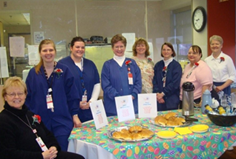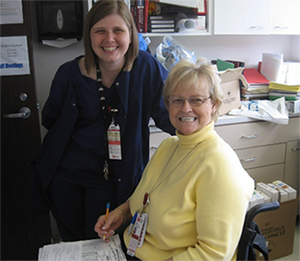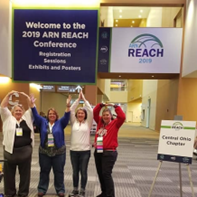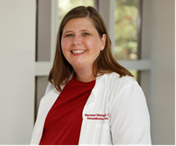President's Message: My Nursing Journey and How You Can Make an Impact on ARN's 50th Anniversary
Maureen Musto, MS APRN-CNS ACNS-BC CRRN FARN, president of the Association of Rehabilitation Nurses (ARN) for the 2023–2025 term, shares her story on becoming a rehabilitation nurse and her leadership journey in practice and as an ARN volunteer.
Deciding to Become a Rehab Nurse
I knew in high school that I wanted to be a rehabilitation nurse. I read an article in my local newspaper about a man who received rehabilitation care after a horrific farm accident. He was able to return home and adapted to be a functioning member of society. I thought that was amazing and I wanted to be a part of that process. I was accepted at The Ohio State University College of Nursing and, as luck would have it, my first clinical in nursing was in acute rehabilitation on the stroke unit. I was hooked! I loved the teamwork of the interdisciplinary staff and how they worked together to improve the lives of the people they served. After my first year of nursing school, I was eligible to apply for a student nurse position and found a job at Dodd Rehabilitation Hospital at The Ohio State University Medical Center. The position was on the brain injury unit; at first I was a little unsure if I would like it, but I grew to love it. I graduated in 1994 with a bachelor's degree in nursing and was soon an RN on the same unit where I worked as a student nurse.
Being a Staff Nurse
I enjoyed being a staff nurse and quickly learned a lot from the physician team's daily educational rounds. I feel fortunate that the nursing team encouraged questions and valued input. We worked as a team and focused on patient barriers to returning to the home setting. I flourished in this role and sought out being the nursing representative in quality meetings, team meetings, and informatics meetings and anything I could do to improve nursing and patient care. I was also encouraged to sit for the CRRN exam when I was eligible, and I'm proud to say I passed. Of note, I was in the last exam group to take the CRRN on paper in December 1996! I had great nursing mentors, and they got me involved in the Central Ohio Chapter of the Association of Rehabilitation Nurses (affectionately called COARN). I enjoyed being part of COARN so much that I was soon on their board of directors, and I have held every office multiple times over the years.
Transitioning to Advanced Practice
I was married in 1998 to my loving husband, Brian. We moved into our first and current house in 1999 and had our first child, Sarah, in 2001. I attained clinical ladder status shortly after Sarah was born, but I still felt the need to advance my career. I decided to go back to school and become a clinical nurse specialist (CNS). Since I was working full time, my progress was slow but steady—I took one class per quarter. I particularly liked the CNS role for its aspects of providing care and consultation to challenging patients, supporting staff nurses, improving quality metrics, and developing programs for process improvement. I had my second child, Maggie, in January 2006 and graduated that June. I took the certification exam to be a clinical nurse specialist and worked as a clinical assistant nurse manager for a year before transitioning to a CNS position in 2008. I have been a CNS since that time. I spent many years enjoying my kid's activities and working as a CNS. I also was able to fit COARN and some remote national volunteer activities into my schedule.
Volunteering for ARN at the National Level
As my kids graduated high school and started college, I began volunteering more for ARN at the national level. I served in a variety of ways, including as an article reviewer for Rehabilitation Nursing Journal, a question writer for the CRRN course, a member of the product and programs committee, and even a reviewer of the core competency model. My rehab friends encouraged me to do more, and I was elected to the ARN Board of Directors in 2019. I have served on the Chapter Development and Fellowship Committees and was highly involved in the Engagement Task Force. I represented ARN in the World Health Organization's development of brain injury interventions that will be incorporated as part of their Rehabilitation Care Initiative. I served an additional year on the board of directors before being elected as president-elect this past summer. I am thrilled that I have been able to be a part of such a fantastic organization and will strive to make positive improvements in my tenure as president.
The 50th Year of ARN: Three Goals for Making an Impact
ARN is celebrating 50 years, and my wish is for the membership to know that ARN is here to support and facilitate the growth of the rehabilitation nurse. You, as an ARN member, can help fulfill the ARN's strategic plan. I have some suggestions for you; it is not all-inclusive but will give you an idea of how you can make an impact.
Goal 1: Engagement
Become engaged with ARN and with your peers within ARN.
- Attend educational meetings at either a local or national level. Many are offered virtually, making it easier than ever to attend.
- Personally invite a friend to attend an ARN or local chapter function.
- Volunteer nationally with your local chapter or on a committee or task force.
- Mentor or precept a fellow rehabilitation nurse.
- Nominate outstanding rehab nurses for awards.
- Participate in Member Circle or join a special interest group.
- Participate in surveys or requests for information from ARN—with knowledge, we can improve!
- Become certified, when eligible.
- Become a Fellow, when eligible.
Goal 2: Visibility
Promote rehabilitation nursing as a specialty.
- Be proud and be recognized as a rehabilitation nurse. Introduce yourself as a rehab nurse.
- For those certified, share that you are credentialed as a rehabilitation expert. Share "I am a CRRN!"
- Reveal your rehab expertise with other specialties and within your organization—via committees, task forces, posters, presentations, and publications.
- Use the research in the Rehabilitation Nursing Journal.
- Support rehab nurses on social media. Make a comment or like rehabilitation accomplishments.
Goal 3: Knowledge and Practice
Advance the science and art of rehabilitation nursing by using and creating research content.
- Donate to the Rehabilitation Nursing Foundation or participate in fundraising activities.
- Complete evidence-based practice projects in a work setting and share them at the ARN Annual Conference or in the Rehabilitation Nursing Journal.
- Participate in educational programs and share what you learned with your peers.
- Communicate with your legislators and use ARN resources to guide you.
- Give feedback to the Centers for Medicare and Medicaid Services when they send a call for comment on rehab proposals for reporting.
About Maureen Musto
Maureen Musto is a clinical nurse specialist at Dodd Rehabilitation Hospital at The Ohio State University Wexner Medical Center (#OSUWexMed). With almost 30 years of rehabilitation nursing experience, she has cared for patients at the bedside and supported rehabilitation nurses in an advanced practice role since 2007. She holds a master of science degree in nursing from The Ohio State University College of Nursing and is certified as a rehabilitation nurse. An active member of the Association of Rehabilitation Nurses, Musto serves on the ARN Board of Directors and became president-elect in 2023. She was awarded the Advanced Practice Role award in 2019. In 2021, Musto was named a Fellow of the Association of Rehabilitation Nurses and awarded the ARN President's Award.
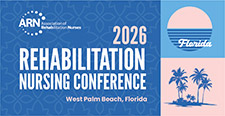
2026 ARN Rehabilitation Nursing Conference
Virtual Experience: July 23-24
In-Person Event: August 2-August 4, West Palm Beach, FL
Earn CNE Your Way
Access live sessions, on-demand recordings, and extended content availability.
Sign Up for Updates
Be the first to know about pricing, speakers, and exclusive opportunities!

